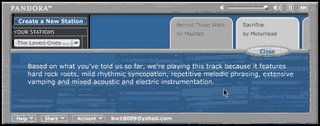College radio (with the exception of stations like WFMU and WSOU) has become almost powerless in it's capacity to really shape the taste of listeners. From my perspective, sending promotional copies for a hardcore/punk/indie rock label to the top 200 is pretty much only good as a street marketing tool, to encourage online support. CMJ Chart numbers are feckless , antiquated barometers of progress and only used by radio departments or indie promoters to justify their jobs. At best, those major-dominated statistics reflect a snapshot of where things were yesterday, instead of where things are going . (Which it was, back in its late 80's/ early 90's heyday.)
Existing radio stations do have the ability to create compelling content for the web, either by webcasting like lefty talk network AirAmerica (oh pardon me, is my progressive showing?) and/or creating podcasts. NPR affiliate Stations like KCRW offer a huge array of sources to their content. (My personal favorite music subscriptions are All Songs Considered, Morning Becomes Eclectic. and Celia Hirschman's music biz show, On The Beat. )
So What's Next?
What's stepping up to the plate? Since Podcasting has been explained to death elsewhere, let's talk about collaboratively filtered online streaming sites like Last.fm or Pandora.com.

Such experiences offer some core similarities:
- Two way relationships between "broadcaster" and "listener"
- The experience starts with the taste of the listener, not some overpaid tool at a corporate office.
- Allows the listener to fast forward (and in some cases) exorcise aurally offensive material from their playist.
- Show song information and graphics
- Enables user to add the music to a permanent collection by linking to online stores.
Pandora's approach is take a song or band you like, and using various properties of that song, will play others. The users' "thumbs up" or "thumbs down" further refines the process. A recent station for Madball then suggests a Motorhead track, based on "hard rock roots, mild rhythmic syncopation, repetitive melodic phrasing, extensive vamping." (vamping?)
Last.fm actually requires you to download a plug-in, which then reports your actual plays of songs through iTunes, Winamp, back to the central site and creates your own personal profile page. Based on your profile, the site will suggest various playlists and other social connections to you. It also allows the user to put cool little dynamic charts on their web pages or blogs. (I'll be adding one soon.)
I'm especially enamored of Last.fm because it allows labels to not only manage their content (inclusive of free promotional downloads) but also link to online shops. They also provide some basic feedback statistics on the music they've uploaded.
In the honorable mention dept, I just tried Rhapsody for Mac. Decent track selection, playlists, but no real filtering or suggestion engine. Today it helped me get my Ramones fix, without having to find and rip a CD or re-purchase it on iTunes.
These are some super cool, yet simultaneously incredibly nerdy, sites that will help reshape "radio" as we know it.
All of the above services have a far greater reach and are far less expensive to utilize than the current solution. With this financial barrier to entry being removed, the paradigm of popular music being dictated by deep-pocketed mega-corps and their sycophantic cronies will shift significantly over the next few years. (If we can keep Newscorp out of it, that is.)
I'm well aware that 12 - 24 year olds aren't the only demographic buying music. (but they're the ones that matter to me the most). I'm sure soccer moms with a Garth Brooks fetish will still listen to country or hit radio while they shuttle junior back and forth to overachiever academy.
The complete marginalization of radio will come as high bandwidth connections become ubiquitous, the "MySpace generation" grows older, and portable media players get cheaper (and even cross with moblie phones.) Nobody can deny that there's no putting the Djini back in the bottle.
But radio isn't the only place the dinosaurs are subject to marketplace Darwinism. It's a brave new world, and the very fabric of the music business is breaking down.
More soon...
2 comments:
I can only shake my head as major record labels continue to cling to outdated notions of how the music biz should work. Can you think of any other industry that is so willing to sue their customer base? The popularity of satellite radio, portable mp3 players, and free music downloads represents the current state of consumer preference in music. The music industry would be better served finding innovative ways to capitalize on these preferences rather than the same old "this is the band we want to sell, so we're going to jam it down your throat via radio and you're going to eat it."
"Vamping" is when a song has only one or two underlying chord structures which a changing melody, usually in the vocals although sometimes in the bass or second guitar, is superimposed over.
For a perfect example of vamping in action, listen to pretty much any pre-Epitaph Hot Water Music track.
Post a Comment